Target Information
| Target General Information | Top | |||||
|---|---|---|---|---|---|---|
| Target ID |
T21357
(Former ID: TTDI02147)
|
|||||
| Target Name |
Phosphodiesterase 3B (PDE3B)
|
|||||
| Synonyms |
cGMPinhibited 3',5'cyclic phosphodiesterase B; cGMP-inhibited 3',5'-cyclic phosphodiesterase B; Cyclic GMPinhibited phosphodiesterase B; Cyclic GMP-inhibited phosphodiesterase B; CGIPDE1; CGIPDE B; CGIP1; CGI-PDE B
Click to Show/Hide
|
|||||
| Gene Name |
PDE3B
|
|||||
| Target Type |
Patented-recorded target
|
[1] | ||||
| Function |
May play a role in fat metabolism. Regulates cAMP binding of RAPGEF3. Through simultaneous binding to RAPGEF3 and PIK3R6 assembles a signaling complex in which the PI3K gamma complex is activated by RAPGEF3 and which is involved in angiogenesis. Cyclic nucleotide phosphodiesterase with a dual-specificity for the second messengers cAMP and cGMP, which are key regulators of many important physiological processes.
Click to Show/Hide
|
|||||
| BioChemical Class |
Phosphoric diester hydrolase
|
|||||
| UniProt ID | ||||||
| EC Number |
EC 3.1.4.17
|
|||||
| Sequence |
MRRDERDAKAMRSLQPPDGAGSPPESLRNGYVKSCVSPLRQDPPRGFFFHLCRFCNVELR
PPPASPQQPRRCSPFCRARLSLGALAAFVLALLLGAEPESWAAGAAWLRTLLSVCSHSLS PLFSIACAFFFLTCFLTRTKRGPGPGRSCGSWWLLALPACCYLGDFLVWQWWSWPWGDGD AGSAAPHTPPEAAAGRLLLVLSCVGLLLTLAHPLRLRHCVLVLLLASFVWWVSFTSLGSL PSALRPLLSGLVGGAGCLLALGLDHFFQIREAPLHPRLSSAAEEKVPVIRPRRRSSCVSL GETAASYYGSCKIFRRPSLPCISREQMILWDWDLKQWYKPHYQNSGGGNGVDLSVLNEAR NMVSDLLTDPSLPPQVISSLRSISSLMGAFSGSCRPKINPLTPFPGFYPCSEIEDPAEKG DRKLNKGLNRNSLPTPQLRRSSGTSGLLPVEQSSRWDRNNGKRPHQEFGISSQGCYLNGP FNSNLLTIPKQRSSSVSLTHHVGLRRAGVLSSLSPVNSSNHGPVSTGSLTNRSPIEFPDT ADFLNKPSVILQRSLGNAPNTPDFYQQLRNSDSNLCNSCGHQMLKYVSTSESDGTDCCSG KSGEEENIFSKESFKLMETQQEEETEKKDSRKLFQEGDKWLTEEAQSEQQTNIEQEVSLD LILVEEYDSLIEKMSNWNFPIFELVEKMGEKSGRILSQVMYTLFQDTGLLEIFKIPTQQF MNYFRALENGYRDIPYHNRIHATDVLHAVWYLTTRPVPGLQQIHNGCGTGNETDSDGRIN HGRIAYISSKSCSNPDESYGCLSSNIPALELMALYVAAAMHDYDHPGRTNAFLVATNAPQ AVLYNDRSVLENHHAASAWNLYLSRPEYNFLLHLDHVEFKRFRFLVIEAILATDLKKHFD FLAEFNAKANDVNSNGIEWSNENDRLLVCQVCIKLADINGPAKVRDLHLKWTEGIVNEFY EQGDEEANLGLPISPFMDRSSPQLAKLQESFITHIVGPLCNSYDAAGLLPGQWLEAEEDN DTESGDDEDGEELDTEDEEMENNLNPKPPRRKSRRRIFCQLMHHLTENHKIWKEIVEEEE KCKADGNKLQVENSSLPQADEIQVIEEADEEE Click to Show/Hide
|
|||||
| 3D Structure | Click to Show 3D Structure of This Target | AlphaFold | ||||
| Cell-based Target Expression Variations | Top | |||||
|---|---|---|---|---|---|---|
| Cell-based Target Expression Variations | ||||||
| Drug Binding Sites of Target | Top | |||||
|---|---|---|---|---|---|---|
| Ligand Name: Isobutylmethylxanthine | Ligand Info | |||||
| Structure Description | CATALYTIC DOMAIN OF HUMAN PHOSPHODIESTERASE 3B IN COMPLEX WITH IBMX | PDB:1SOJ | ||||
| Method | X-ray diffraction | Resolution | 2.90 Å | Mutation | No | [3] |
| PDB Sequence |
LDLILVEEYD
668 SLIEKMSNWN678 FPIFELVEKM688 GEKSGRILSQ698 VMYTLFQDTG708 LLEIFKIPTQ 718 QFMNYFRALE728 NGYRDIPYHN738 RIHATDVLHA748 VWYLTTRPVP758 GLQQIHNGRI 784 AYISSKSCSN794 PDESYGCLSS804 NIPALELMAL814 YVAAAMHDYD824 HPGRTNAFLV 834 ATNAPQAVLY844 NDRSVLENHH854 AASAWNLYLS864 RPEYNFLLHL874 DHVEFKRFRF 884 LVIEAILATD894 LKKHFDFLAE904 FNAKANDVNS914 NGIEWSNEND924 RLLVCQVCIK 934 LADINGPAKV944 RDLHLKWTEG954 IVNEFYEQGD964 EEANLGLPIS974 PFMDRSSPQL 984 AKLQESFITH994 IVGPLCNSYD1004 AAGLLPGQWL1014 EAESRRRIFC1059 QLMHHLTENH 1069 KIWK
|
|||||
|
|
||||||
| Ligand Name: 1-Deoxy-1-[(2-hydroxyethyl)(nonanoyl)amino]hexitol | Ligand Info | |||||
| Structure Description | CATALYTIC DOMAIN OF HUMAN PHOSPHODIESTERASE 3B In COMPLEX WITH A DIHYDROPYRIDAZINE INHIBITOR | PDB:1SO2 | ||||
| Method | X-ray diffraction | Resolution | 2.40 Å | Mutation | No | [3] |
| PDB Sequence |
LDLILVEEYD
668 SLIEKMSNWN678 FPIFELVEKM688 GEKSGRILSQ698 VMYTLFQDTG708 LLEIFKIPTQ 718 QFMNYFRALE728 NGYRDIPYHN738 RIHATDVLHA748 VWYLTTRPVP758 GLQQIHNGGR 783 IAYISSKSCS793 NPDESYGCLS803 SNIPALELMA813 LYVAAAMHDY823 DHPGRTNAFL 833 VATNAPQAVL843 YNDRSVLENH853 HAASAWNLYL863 SRPEYNFLLH873 LDHVEFKRFR 883 FLVIEAILAT893 DLKKHFDFLA903 EFNAKANDVN913 SNGIEWSNEN923 DRLLVCQVCI 933 KLADINGPAK943 VRDLHLKWTE953 GIVNEFYEQG963 DEEANLGLPI973 SPFMDRSSPQ 983 LAKLQESFIT993 HIVGPLCNSY1003 DAAGLLPGQW1013 LESRRRIFCQ1060 LMHHLTENHK 1070 IWK
|
|||||
|
|
||||||
| Click to View More Binding Site Information of This Target with Different Ligands | ||||||
| Different Human System Profiles of Target | Top |
|---|---|
|
Human Similarity Proteins
of target is determined by comparing the sequence similarity of all human proteins with the target based on BLAST. The similarity proteins for a target are defined as the proteins with E-value < 0.005 and outside the protein families of the target.
A target that has fewer human similarity proteins outside its family is commonly regarded to possess a greater capacity to avoid undesired interactions and thus increase the possibility of finding successful drugs
(Brief Bioinform, 21: 649-662, 2020).
Human Tissue Distribution
of target is determined from a proteomics study that quantified more than 12,000 genes across 32 normal human tissues. Tissue Specificity (TS) score was used to define the enrichment of target across tissues.
The distribution of targets among different tissues or organs need to be taken into consideration when assessing the target druggability, as it is generally accepted that the wider the target distribution, the greater the concern over potential adverse effects
(Nat Rev Drug Discov, 20: 64-81, 2021).
Human Pathway Affiliation
of target is determined by the life-essential pathways provided on KEGG database. The target-affiliated pathways were defined based on the following two criteria (a) the pathways of the studied target should be life-essential for both healthy individuals and patients, and (b) the studied target should occupy an upstream position in the pathways and therefore had the ability to regulate biological function.
Targets involved in a fewer pathways have greater likelihood to be successfully developed, while those associated with more human pathways increase the chance of undesirable interferences with other human processes
(Pharmacol Rev, 58: 259-279, 2006).
Biological Network Descriptors
of target is determined based on a human protein-protein interactions (PPI) network consisting of 9,309 proteins and 52,713 PPIs, which were with a high confidence score of ≥ 0.95 collected from STRING database.
The network properties of targets based on protein-protein interactions (PPIs) have been widely adopted for the assessment of target’s druggability. Proteins with high node degree tend to have a high impact on network function through multiple interactions, while proteins with high betweenness centrality are regarded to be central for communication in interaction networks and regulate the flow of signaling information
(Front Pharmacol, 9, 1245, 2018;
Curr Opin Struct Biol. 44:134-142, 2017).
Human Similarity Proteins
Human Tissue Distribution
Human Pathway Affiliation
Biological Network Descriptors
|
|
|
There is no similarity protein (E value < 0.005) for this target
|
|
Note:
If a protein has TS (tissue specficity) scores at least in one tissue >= 2.5, this protein is called tissue-enriched (including tissue-enriched-but-not-specific and tissue-specific). In the plots, the vertical lines are at thresholds 2.5 and 4.
|
| KEGG Pathway | Pathway ID | Affiliated Target | Pathway Map |
|---|---|---|---|
| Purine metabolism | hsa00230 | Affiliated Target |
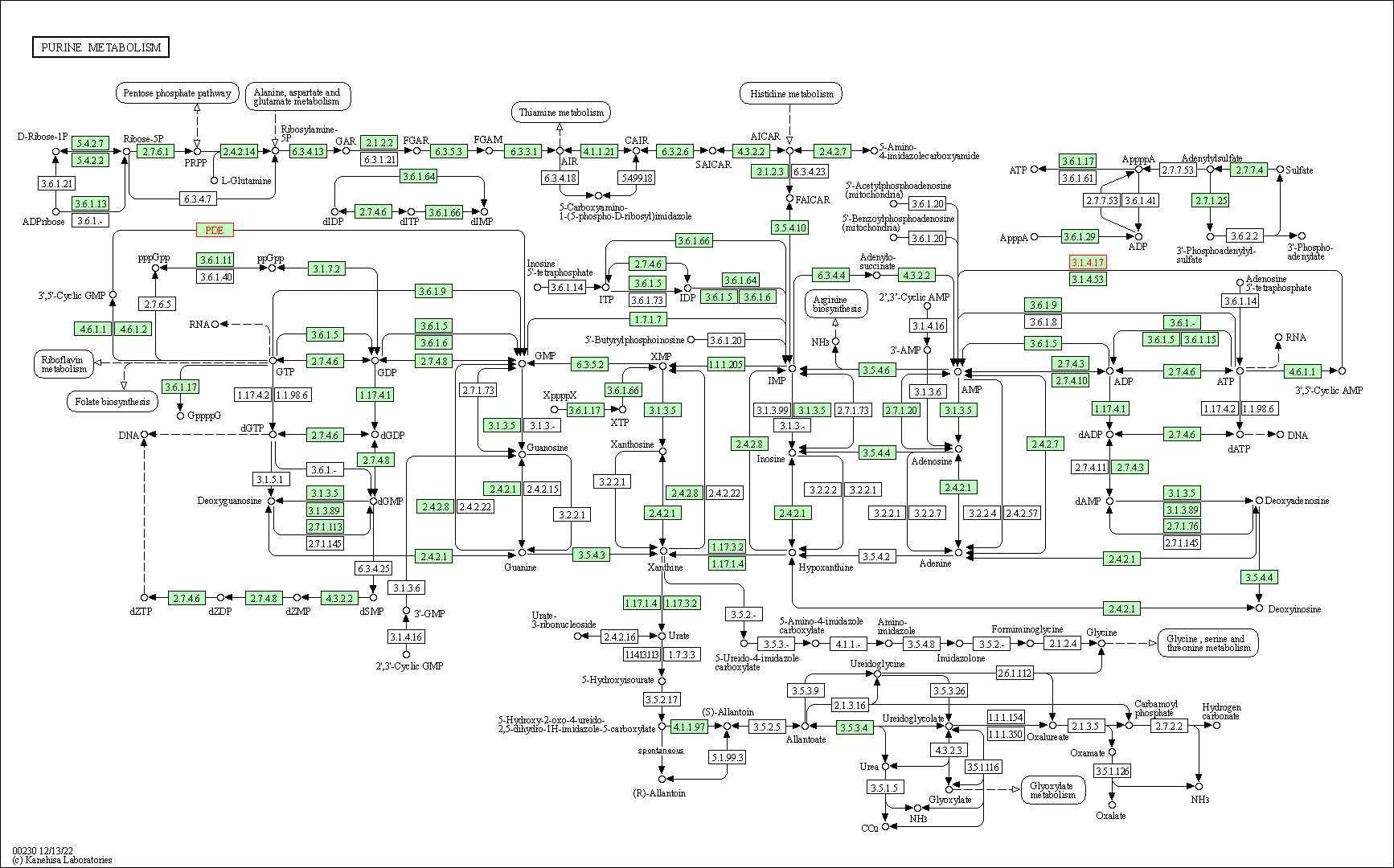
|
| Class: Metabolism => Nucleotide metabolism | Pathway Hierarchy | ||
| cGMP-PKG signaling pathway | hsa04022 | Affiliated Target |
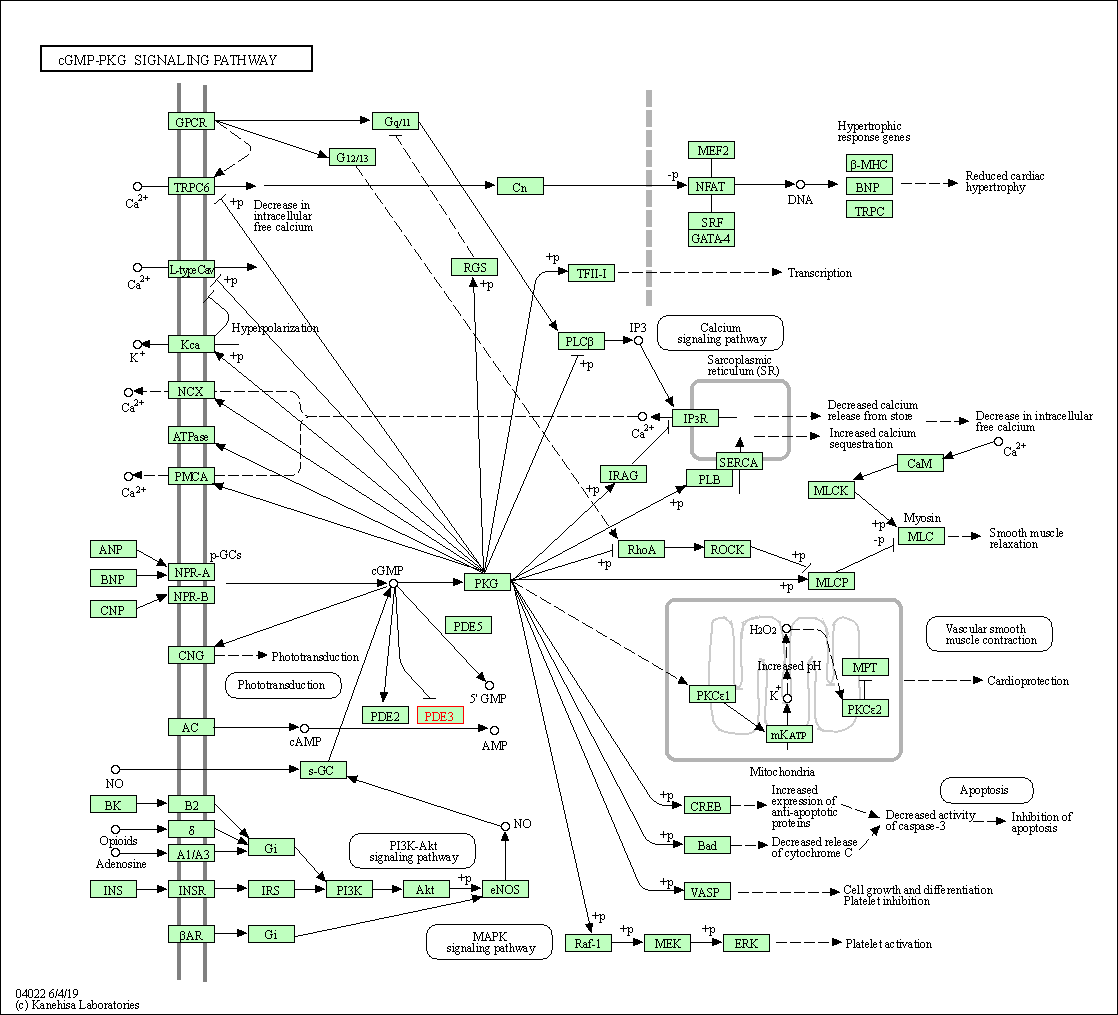
|
| Class: Environmental Information Processing => Signal transduction | Pathway Hierarchy | ||
| cAMP signaling pathway | hsa04024 | Affiliated Target |
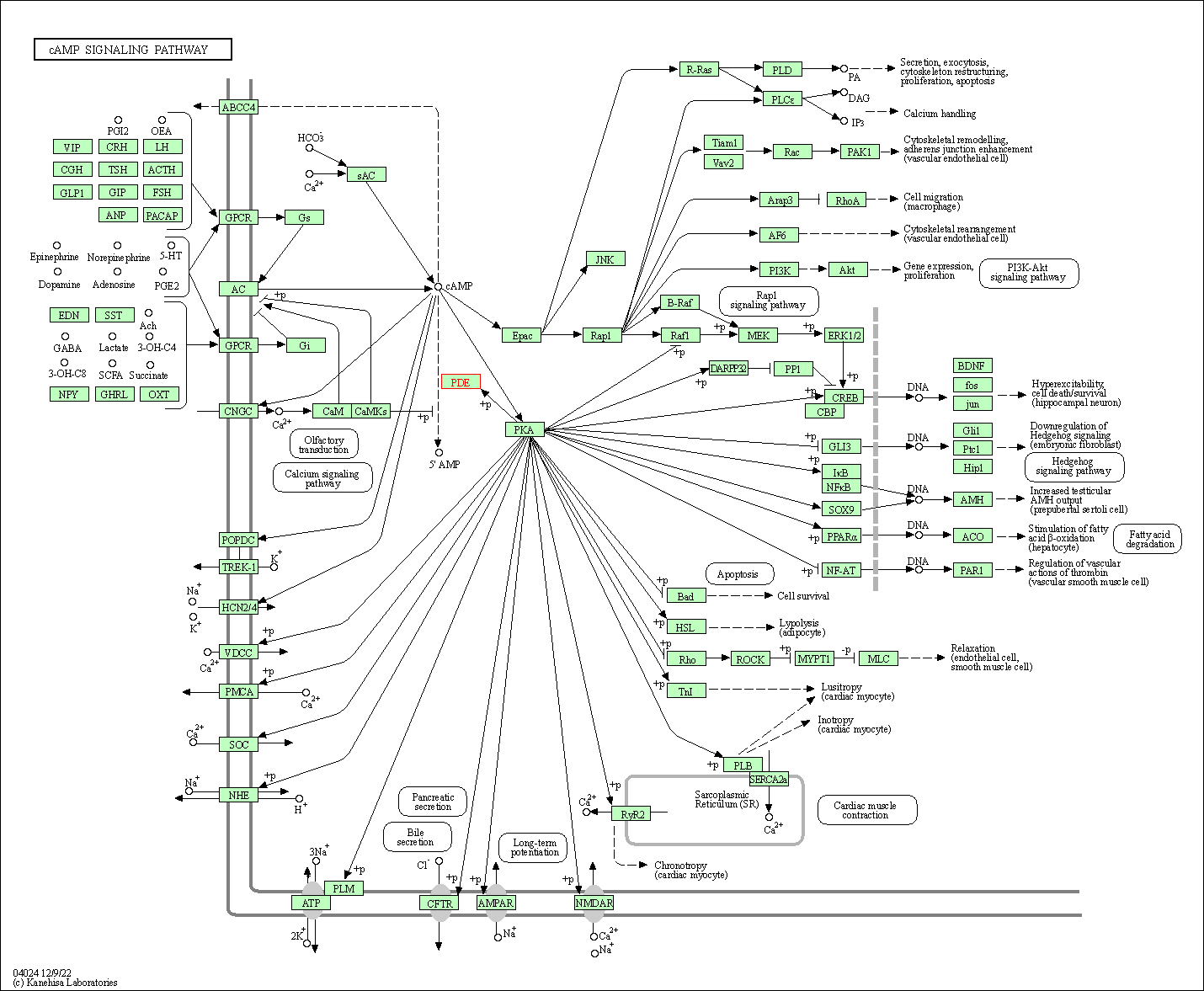
|
| Class: Environmental Information Processing => Signal transduction | Pathway Hierarchy | ||
| Apelin signaling pathway | hsa04371 | Affiliated Target |
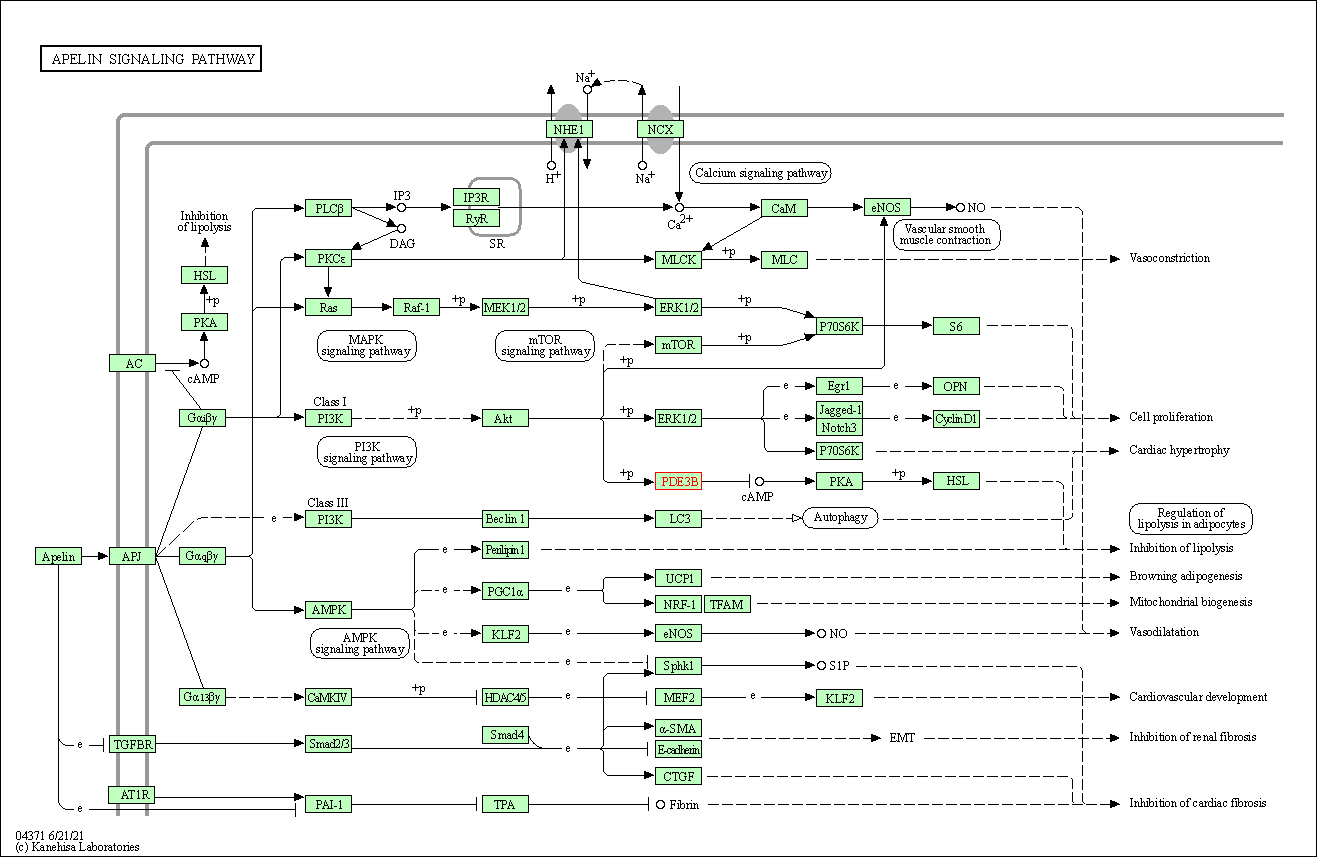
|
| Class: Environmental Information Processing => Signal transduction | Pathway Hierarchy | ||
| Insulin signaling pathway | hsa04910 | Affiliated Target |
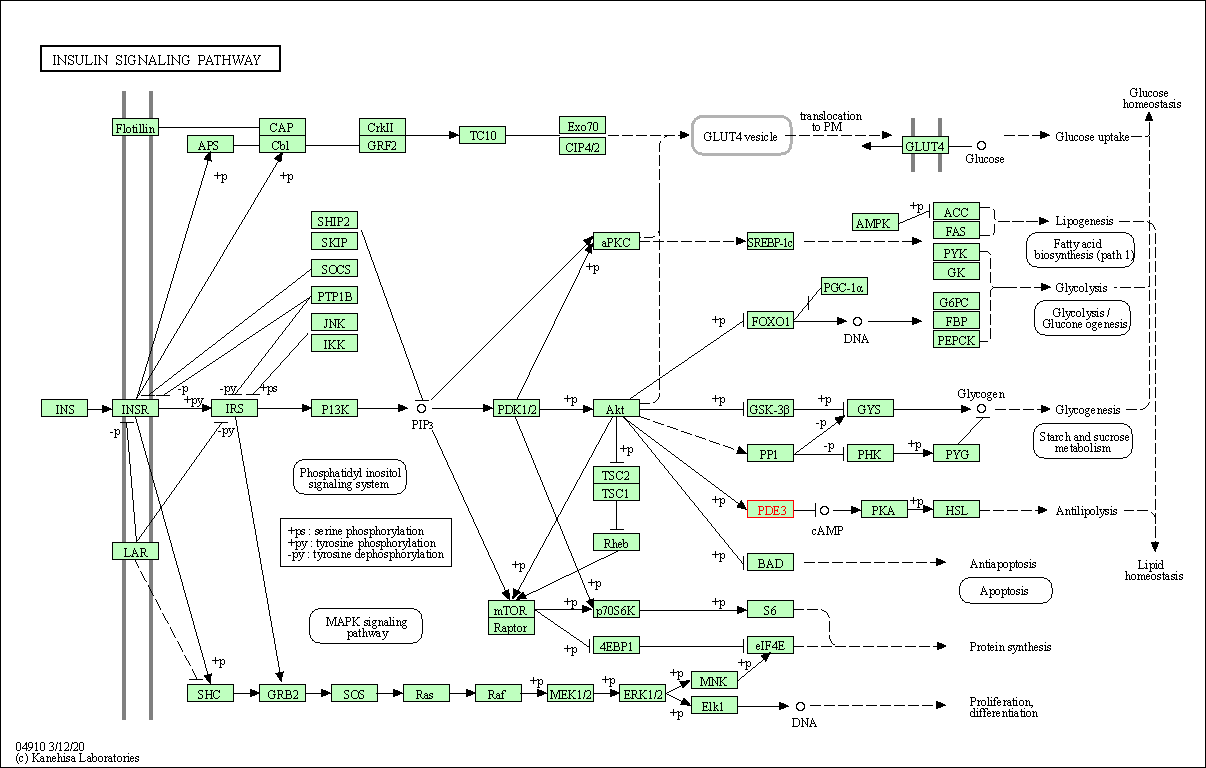
|
| Class: Organismal Systems => Endocrine system | Pathway Hierarchy | ||
| Progesterone-mediated oocyte maturation | hsa04914 | Affiliated Target |
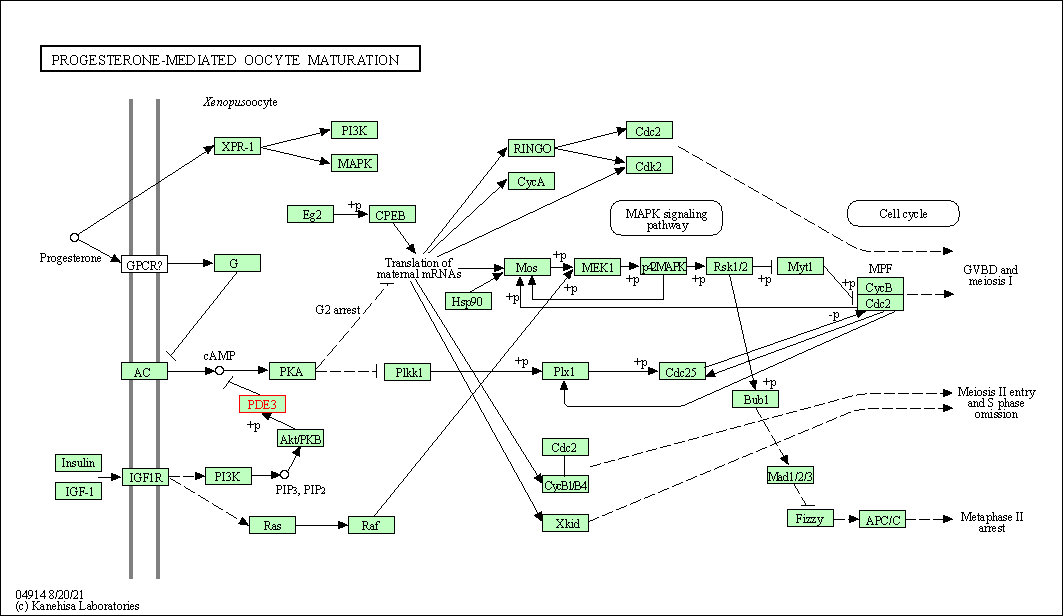
|
| Class: Organismal Systems => Endocrine system | Pathway Hierarchy | ||
| Glucagon signaling pathway | hsa04922 | Affiliated Target |
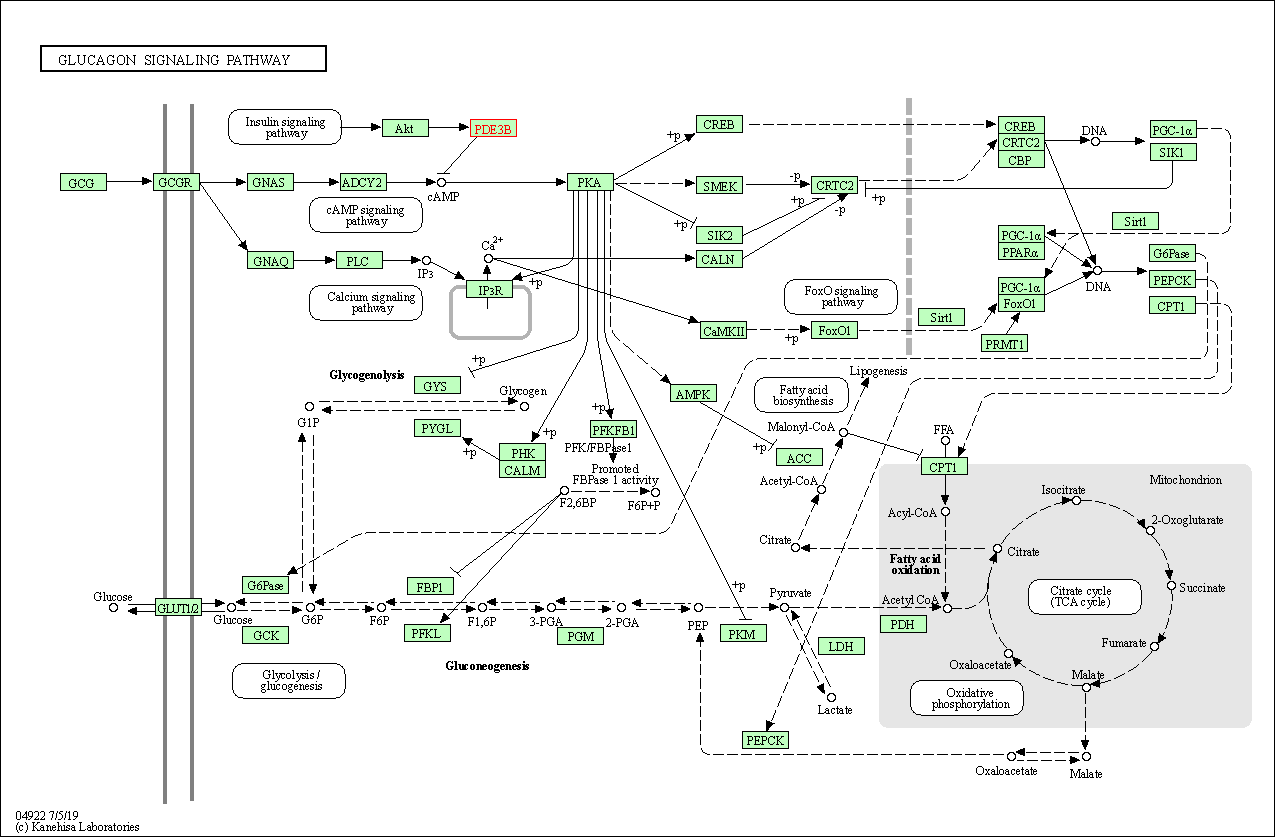
|
| Class: Organismal Systems => Endocrine system | Pathway Hierarchy | ||
| Regulation of lipolysis in adipocytes | hsa04923 | Affiliated Target |
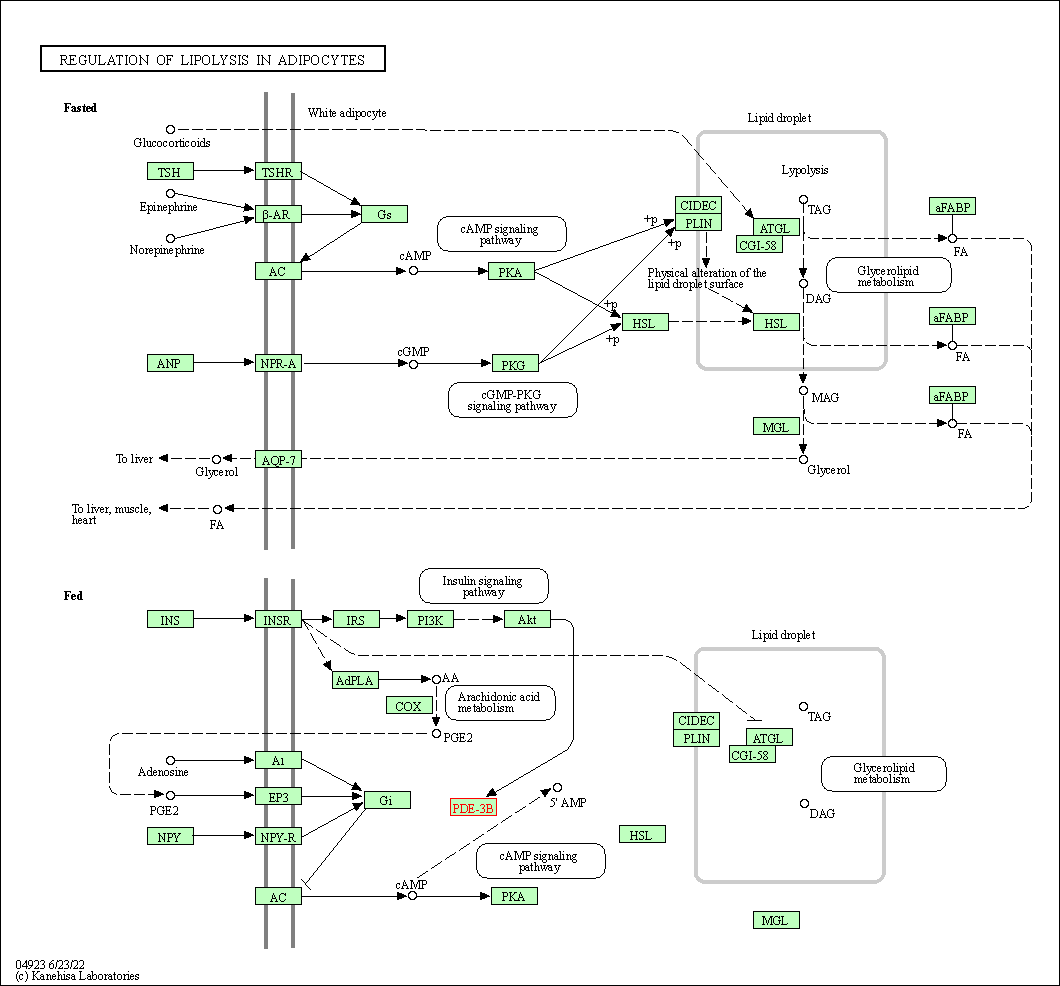
|
| Class: Organismal Systems => Endocrine system | Pathway Hierarchy | ||
| Renin secretion | hsa04924 | Affiliated Target |
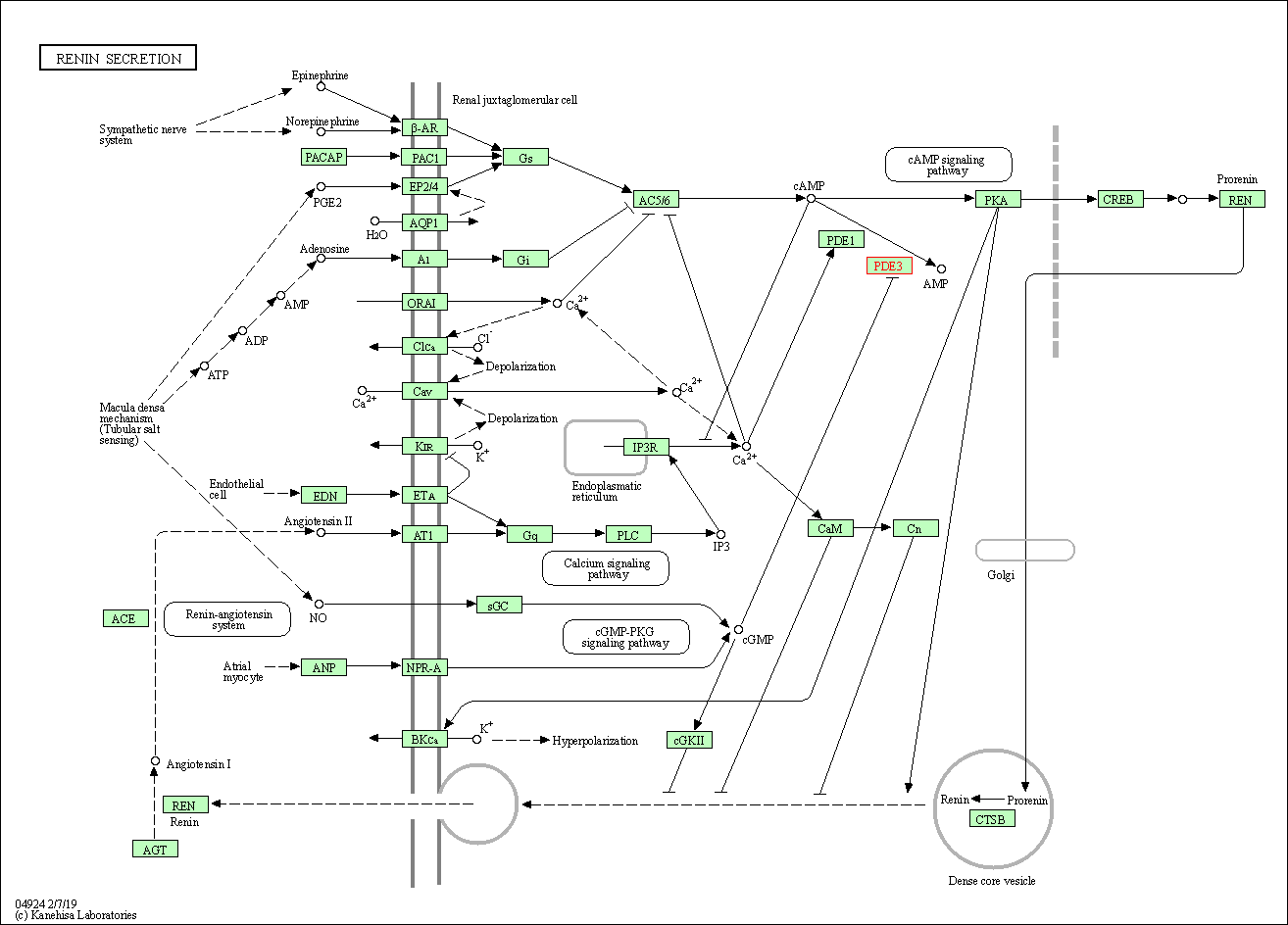
|
| Class: Organismal Systems => Endocrine system | Pathway Hierarchy | ||
| Click to Show/Hide the Information of Affiliated Human Pathways | |||
| Degree | 2 | Degree centrality | 2.15E-04 | Betweenness centrality | 0.00E+00 |
|---|---|---|---|---|---|
| Closeness centrality | 1.91E-01 | Radiality | 1.33E+01 | Clustering coefficient | 1.00E+00 |
| Neighborhood connectivity | 1.25E+01 | Topological coefficient | 5.68E-01 | Eccentricity | 13 |
| Download | Click to Download the Full PPI Network of This Target | ||||
| Chemical Structure based Activity Landscape of Target | Top |
|---|---|
| Target Poor or Non Binders | Top | |||||
|---|---|---|---|---|---|---|
| Target Poor or Non Binders | ||||||
| Target Profiles in Patients | Top | |||||
|---|---|---|---|---|---|---|
| Target Expression Profile (TEP) | ||||||
| Target Affiliated Biological Pathways | Top | |||||
|---|---|---|---|---|---|---|
| NetPath Pathway | [+] 2 NetPath Pathways | + | ||||
| 1 | TCR Signaling Pathway | |||||
| 2 | IL2 Signaling Pathway | |||||
| PID Pathway | [+] 1 PID Pathways | + | ||||
| 1 | Class IB PI3K non-lipid kinase events | |||||
| References | Top | |||||
|---|---|---|---|---|---|---|
| REF 1 | NCBI GEO: archive for functional genomics data sets--update. Nucleic Acids Res. 2013 Jan;41(Database issue):D991-5. | |||||
| REF 2 | Derivatives of celeboxib, use thereof and preparation thereof. US9388139. | |||||
| REF 3 | Crystal structure of human phosphodiesterase 3B: atomic basis for substrate and inhibitor specificity. Biochemistry. 2004 May 25;43(20):6091-100. | |||||
If You Find Any Error in Data or Bug in Web Service, Please Kindly Report It to Dr. Zhou and Dr. Zhang.

